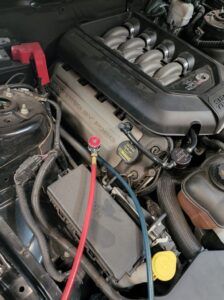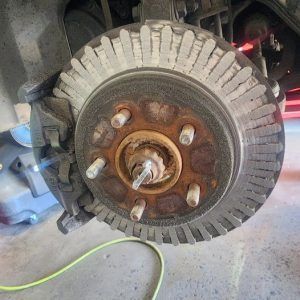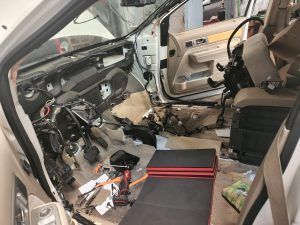An Introduction To Different Types Of Brake Pads
If you’re a car owner, you know that brakes are an essential component of your vehicle. When it comes to brake pads, there are various types available on the market. Each type has its unique qualities that determine its performance, lifespan, and price. It’s crucial to understand the different types of brake pads to ensure you make the right choice for your car and driving style.
In this article, we’ll introduce you to the three main types of brake pads: ceramic, organic, and metallic. We’ll explore the pros and cons of each type, their features, and their suitability for different driving conditions.
We’ll also guide you on how to choose the right brake pads for your car, so you can make an informed decision and ensure your safety on the road. Additionally, we’ll provide you with tips on how to maintain your brake pads to extend their lifespan and keep them working efficiently.
So, let’s dive into the world of brake pads and discover what makes them different and how you can choose the best option for your vehicle.
Key Takeaways
– There are three main types of brake pads: ceramic, organic, and metallic.
– Choosing the right brake pads depends on factors such as driving style, budget, and environment.
– Regular maintenance is crucial for extending the lifespan and ensuring the efficiency of brake pads.
– Neglecting brake pad maintenance can lead to reduced braking power and even brake failure, putting passengers at risk.
Ceramic Brake Pads
Ceramic brake pads, known for their durability and low noise, are an excellent choice for high-performance vehicles. They are made of a mix of ceramic fibers, non-ferrous filler materials, and bonding agents. The ceramic compounds are designed to withstand high temperatures, making them ideal for racing or other demanding driving conditions.
The absence of metal in their composition also means that they produce less dust and are less abrasive to the rotors. One of the main advantages of ceramic brake pads is their ability to dissipate heat quickly. This reduces the risk of brake fade, which is when the brakes lose their effectiveness due to overheating.
Ceramic pads also have a longer lifespan than other types of brake pads, which means they need to be replaced less frequently. They are also less likely to produce noise or vibrations when braking. However, ceramic brake pads also have some disadvantages.
They can be more expensive than other types of brake pads, which may not be cost-effective for some drivers. They also require a specific type of rotor to work effectively, which means that they may not be compatible with all vehicles. Additionally, ceramic brake pads may not be suitable for drivers who are looking for maximum stopping power, as they are designed to provide consistent braking over a longer period of time.
Organic brake pads are another type of brake pad that is commonly used in vehicles. These pads are made of organic materials such as rubber, glass, and Kevlar, and are designed to be gentle on the rotors.
Organic Brake Pads
When it comes to brake pads, organic options are made from materials such as rubber, glass, and even Kevlar. These types of brake pads are known for their quieter operation and less dust production compared to other types of brake pads. If you’re looking for a brake pad that’s environmentally friendly and provides good stopping power, an organic brake pad might be the right choice for you.
Composition of Organic Brake Pads
You’ll love the composition of organic brake pads because they’re made from non-metallic materials like rubber, Kevlar, and fiberglass. These materials make organic brake pads a popular choice among environmentally conscious drivers, as they produce less brake dust and have a lower impact on the environment than their metallic counterparts. Additionally, organic brake pads tend to be more affordable than other types of brake pads, making them a practical choice for many drivers.
To better understand the composition of organic brake pads, here are four key components that make up this type of brake pad:
1. Organic brake pads are made from a mixture of rubber, Kevlar, and fiberglass, which provides a level of durability and strength that allows them to handle high-pressure braking.
2. The organic materials in these brake pads create a softer and more flexible pad that generates less noise and vibration when braking.
3. The bonding agents used in organic brake pads are typically non-metallic and don’t contain harmful substances, making them safer for the environment.
4. The use of organic materials in brake pads also means that they produce less brake dust, which can help to keep wheels and rims clean and reduce maintenance costs.
With their unique composition, organic brake pads offer several advantages over other types of brake pads. In the next section, we’ll look at how this composition leads to quieter operation.
Quieter Operation
If you want a brake pad that won’t screech and rattle every time you come to a stop, organic brake pads are the way to go. These brake pads are made of materials like rubber, glass, and Kevlar, which are much quieter than the metallic compounds found in non-organic brake pads.
This means that you can enjoy a smoother and more pleasant ride without having to deal with the loud and annoying noises that other brake pads can make. In addition to providing a quieter operation, organic brake pads also offer improved performance and longer lifespan compared to other types of brake pads.
They have a softer texture that allows them to grip the rotor more effectively, which results in better stopping power and shorter stopping distances. Plus, they generate less heat than metallic brake pads, which can help prevent warping and prolong the life of your brake system.
With all these benefits, it’s no wonder that organic brake pads are a popular choice for drivers who want a reliable and efficient braking system. As we move on to discussing less dust production, you’ll see that organic brake pads offer even more advantages over their counterparts.
Less Dust Production
Organic brake pads produce significantly less dust than their metallic counterparts, making them a cleaner and more environmentally-friendly option for drivers. The reduced pollution caused by organic brake pads is due to their composition, which consists of a mix of materials such as rubber, glass, and Kevlar. These materials are less abrasive than the metallic components used in metallic brake pads, resulting in less wear and tear on the rotor and caliper.
Furthermore, the environmental impact of organic brake pads is much less significant than that of metallic brake pads. The dust produced by metallic brake pads contains copper and other heavy metals that are toxic to the environment. This dust can enter streams and rivers, polluting the water and harming wildlife. Organic brake pads, on the other hand, produce minimal dust and do not contain any heavy metals, making them a safer and more sustainable option for drivers.
In contrast to organic brake pads, metallic brake pads produce more dust and have a greater environmental impact due to the presence of toxic metals. However, metallic brake pads have their own advantages, such as better performance under high temperatures.
Metallic Brake Pads
Metallic brake pads are a popular choice for those who drive in extreme conditions and need a brake pad that can handle high temperatures and heavy use. These brake pads are made of a mixture of metals, such as copper, iron, and steel, and provide great stopping power. They are also known for their durability and longevity, as they can last longer than other types of brake pads.
One advantage of metallic brake pads is their ability to handle high temperatures without fading. This makes them a great choice for those who drive in mountainous regions or those who do a lot of towing. However, there are also some disadvantages to using metallic brake pads. They tend to produce more dust and can be noisier than other types of brake pads. Additionally, they can be harsh on rotors, leading to faster wear and tear.
When compared to other types of brake pads, metallic brake pads are generally more affordable and offer better performance in extreme conditions. However, they may not be the best choice for those who prioritize a quiet and clean driving experience.
It’s important to consider your driving habits and needs when choosing the right brake pads for your vehicle. Considering the type of driving you do and the needs of your vehicle can help you make an informed decision about the type of brake pads to use. Next, we’ll explore some factors to consider when choosing the right brake pads for your vehicle.
Choosing the Right Brake Pads
When it comes to selecting brake pads for your vehicle, there are several factors to consider. First and foremost, you need to think about the type of driving you do. If you drive in stop-and-go traffic or frequently tow heavy loads, you’ll want to opt for a more durable brake pad.
Secondly, you’ll need to consider your budget. Higher-end brake pads may offer better performance, but they’ll also come with a higher price tag.
Finally, you’ll need to think about the environment you’re driving in. If you live in an area with lots of hills or steep grades, you’ll want to choose a brake pad that can handle the added stress.
When comparing brake pads to other brake components, it’s important to note that they’re just one piece of the larger braking system. Brake pads work in tandem with the rotors, calipers, and brake fluid to bring your vehicle to a stop.
While brake pads are important, they’re not the only thing that affects your vehicle’s stopping power. For example, if your brake rotors are warped or damaged, your brake pads won’t be able to do their job effectively.
Choosing the right brake pads for your vehicle requires careful consideration of several key factors. You’ll need to think about your driving habits, budget, and environment when making your decision. Additionally, it’s important to remember that brake pads are just one part of your vehicle’s braking system. To ensure your brakes are working at their best, you’ll need to maintain all of the components of your braking system.
Maintaining Brake Pads
Maintaining your brake pads is crucial to ensure your safety on the road. Regular brake maintenance can help you avoid costly repairs and replacements in the long run.
Keep an eye out for signs of brake pad wear, such as squeaking or grinding noises. Replace your brake pads as soon as they start to wear down to avoid further damage to your vehicle’s braking system.
Importance of Regular Brake Maintenance
Regular brake maintenance is crucial for ensuring the safety and longevity of your vehicle’s braking system. Here are some benefits of brake maintenance that you should be aware of:
– Increases brake pad lifespan and saves you money in the long run
– Improves stopping distance and ensures better control of your vehicle
– Helps prevent common brake problems like brake fade, squeaking, and vibration
– Reduces the risk of accidents and keeps you and your passengers safe
– Maintains the overall health of your vehicle’s braking system and prevents costly repairs.
Neglecting brake maintenance can lead to severe consequences, such as reduced braking power, longer stopping distances, and even complete brake failure. This is why it’s essential to pay attention to signs of brake wear and take your vehicle to a professional mechanic as soon as possible.
In the next section, we’ll discuss the signs of brake pad wear that you should look out for.
Signs of Brake Pad Wear
It’s important for you to keep an eye out for signs of worn brake pads to ensure your safety and prevent costly repairs.
One of the most common signs of worn brake pads is a high-pitched squealing or grinding noise when you apply the brakes. This noise is caused by the wear indicator, which is a small piece of metal that rubs against the rotor when the brake pads are worn down.
Another sign of worn brake pads is reduced braking performance. If you notice that your car is taking longer to stop or the brake pedal feels spongy, it’s time to have your brake pads inspected.
The lifespan of brake pads varies depending on driving habits, road conditions, and other factors, but most brake pads need to be replaced every 30,000 to 70,000 miles.
To ensure your safety and prevent costly repairs, it’s important to replace your brake pads when they are worn down.
In the next section, we’ll discuss the process for replacing brake pads.
Replacing Brake Pads
When replacing your worn brake pads, you’ll need to first remove the wheel and caliper to access the brake pads.
It’s important to take note of the condition of the brake rotors and replace them if they’re worn or damaged.
To prevent brake pad wear, make sure to use the brakes appropriately and avoid sudden stops or heavy braking.
Regular maintenance such as cleaning the brake system and checking the brake fluid level can help prolong the lifespan of your brake pads.
Cost-effective brake pad replacements are available in the market, but it’s important to choose a high-quality and reliable brand.
Some options include ceramic brake pads which are known for their durability and low noise level.
Semi-metallic brake pads are another option that offer good performance and are suitable for a wide range of vehicles.
When replacing your brake pads, it’s also a good idea to replace the hardware such as the clips and shims to ensure proper function of the braking system.
Proper installation and maintenance of your brake pads can help ensure the safety of you and your passengers on the road.
Frequently Asked Questions
Are there any eco-friendly brake pad options available?
Looking for eco-friendly alternatives to traditional brake pads? Consider options made from materials like ceramic or organic compounds. These options can reduce the environmental impact of your vehicle’s braking system while still providing reliable performance.
How do brake pads affect the overall braking system of a vehicle?
Brake pad material can significantly impact the overall braking performance of your vehicle. Different materials, such as ceramic or metallic, offer varying levels of durability, heat resistance, and stopping power. Choosing the right material for your vehicle can improve safety and efficiency on the road.
Can brake pads be reused or recycled after they have worn down?
After a brake pad has worn down, it cannot be reused. However, it can be recycled to reduce the environmental impact. Brake pad recycling involves separating the metal and organic materials to be reused in other products.
How often should brake pads be replaced, and what are the warning signs of worn brake pads?
To ensure proper brake pad maintenance and avoid worn brake pad effects, replace them every 25,000-70,000 miles depending on driving habits. Warning signs of worn pads include squeaking, grinding, and reduced braking performance.
Are there any specific safety precautions to take when replacing brake pads?
When replacing brake pads, wear proper safety gear like goggles and gloves. Dispose of old brake pads in a designated container to avoid environmental contamination. Always follow manufacturer instructions for installation.
Conclusion
Congratulations, you’ve reached the end of this article that provided you with an introduction to the different types of brake pads.
By now, you should have a good understanding of the advantages and disadvantages of ceramic, organic, and metallic brake pads, which will help you make an informed decision when choosing the right brake pads for your vehicle.
Remember, when choosing the right brake pads, you should consider your driving style, vehicle type, and budget. Additionally, it’s essential to maintain your brake pads regularly to ensure that they’re functioning correctly and to prolong their lifespan.
Regular maintenance includes checking the brake pads for wear and tear, cleaning the braking system, and replacing the brake fluid when necessary.
In conclusion, brake pads are a crucial component of your vehicle’s braking system, and choosing the right brake pads can make a significant difference in your vehicle’s performance and safety.
By understanding the different types of brake pads and maintaining them regularly, you can ensure that your vehicle’s braking system is functioning correctly and keeping you safe on the road.







